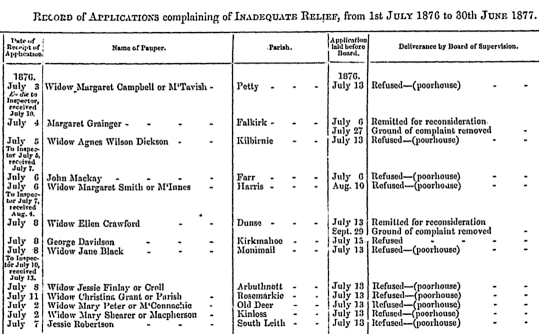Scottish Poor Relief and Poorhouse Records
Prior to 1845, the funding and administration of poor relief in Scotland was shared by the kirk sessions (church authorities) and heritors (landowners) in each parish. Support for the destitute was mostly through outdoor relief - handouts of money, food, clothing or fuel - although Edinburgh, Glasgow and towns such as Ayr, Dunfermline and Aberdeen also established poorhouses to house the destitute. The most significant records from this period are the minute books and accounts of the heritors and kirk sessions which include details of poor relief applications and payments. Other surviving documents may include parish poors rolls - lists of named individuals receiving relief such as cash or portions of oatmeal.
In 1845, the Poor Law (Scotland) Act introduced a new system of poor relief, still parish-based but administered by Parochial Boards (Parish Councils from 1894). Poor relief - from which the able-bodied were explicitly excluded - could be given in cash or in kind, and large parishes could also set up a poorhouse their sick or destitute poor. Groups or 'combinations' of smaller parishes could join together to administer poor relief and operate a shared poorhouse.
The new system was overseen by a central Board of Supervision but was still locally financed. Parishes could choose to continue funding relief through the kirk sessions and heritors, or move to a property rates based system - something which most parishes gradually opted to do over the next thirty years. Within this period, family historians may need to consult kirk sessions' and heritors' records as well as those kept by Parochial Boards.
As in England, a Scottish parish was only obliged to relieve those who were legally settled there. Settlement in Scotland was based on the place of birth or by continuous residence in another parish for seven years.
Applying for Poor Relief
After 1845, someone applying for poor relief would be interviewed in their own home by the parish's Inspector of the Poor. The details of the claim (whether successful or not) were recorded in a register of relief applications. This can be a particularly rich resource with details of the applicant's name, age, birthplace, residence, marital status, occupation, religion, earnings', names and ages of dependants, disabilities, any other relevant information, and details of any previous applications.
It should be noted that, as is often the custom in Scotland, married women may be entered in relief records under their maiden name. Names may sometimes also be spelled phonetically. In addition, the occupations stated may not always be reliable or consistent. An applicant might, for example, initially describe himself as an unskilled labourer in the hope of this helping his claim. In a subsequent application, he might describe himself as a weaver.
One of the largest collections of poor relief applications is held at Glasgow's Mitchell Library which holds more than one million in its archives. These include not only those made by residents of Glasgow but also those from the counties of Bute, Dunbartonshire, Lanarkshire and Renfrewshire.
The names of those granted poor relief were compiled in each parish's General Register of the Poor listing each claimant's details (name, age, address, birthplace, occupation, dependants) and the amount and type of relief (cash, clothing, medicine etc) that they were awarded by the Parochial Board.
Appeal Records
Those whose claims for poor relief were refused by the Parochial Board could appeal to their county Sheriff Court. Sheriff Courts kept voluminous records but their format and content varies and so can present quite a challenge for researchers. In some cases, there may be documents specifically relating to poor relief such as the Poor Laws Minute Book kept by the Elgin Sheriff Court.
Individuals who felt that the relief they had been granted by the Parochial Board was inadequate could appeal to the Scottish Board of Supervision (succeeded by the Local Government Board in 1894), whose annual reports list each claimant's name, parish and appeal verdict. These reports form part of the British Parliamentary Papers collection (subscription required but accessible free via many UK libraries).

Sample of SBS Appeals Summary, 1876-7.
Poorhouse Records
For those who ended up in the poorhouse, records were kept of admissions and discharges and matters such as inmates' deaths and punishments. These include basic details such as name, age, birthplace, denomination, trade, cause of leaving (usually dead or discharged), parish of settlement, and comments.
As well as relief records, poorhouse inmates feature, of course, in civil records such as the census and birth/death registers, the major online source being Scotland's People. In 1921, Scotland adopted the English practice of disguising the location of births and deaths taking place in a poorhouse by substituting an anonymous street address.
Locating Records
Surviving local poor law records are generally found at the relevant county or metropolitan archives. A good finding aid is the Scottish Archives Network (SCAN) website. Searching the SCAN online catalogue for, say, 'Inverness' and 'poor' will detail the surviving records at the Highland Council Archive Service in Inverness.
Records relating to adults are usually closed for 75 years and for 100 years in respect of children, so before travelling to a record office, always check that the records you need are available for consultation.
The National Records of Scotland (the new face of the National Archives of Scotland) holds a variety of pre- and post-1845 material including poors rolls, Kirk Session and Heritors' minutes, and poorhouse architectural plans. Its online catalogue includes its own holdings and those elsewhere in Scotland.
Some indexes or transcriptions of poor relief records are viewable online, a good example being the indexes to the Liff and Benvie Register of the Poor and the Dundee East Poorhouse Register available at www.fdca.org.uk.
Examples of a variety of different poor relief records can be viewed on SCAN website
Unless otherwise indicated, this page () is copyright Peter Higginbotham. Contents may not be reproduced without permission.



